Botanical name:
Basella rubra
Description:
Herbaceous semi succulent perennial plant with vines up to 10 m long. The stems are red and soft. The leaves are heart-shaped. Reported to be high in calcium, iron, soluble fibre and vitamins A and C. The whole plant is edible.
How to grow:
The plant is actually a perennial, but is better controlled started over from seeds each year, this also allows for crop rotation. Start from seed in a seedbed in early Spring and transplant when 10 cm high. Space 40 cm apart.
Grows best in sandy soils rich with organic matter. Likes to grow in full sun under tropical conditions and good water supply. Is rather drought tolerant but won’t grow as prolific in drought conditions. Prefers a fairly high pH from 5.5 to 8.
Needs a structure to grow on. Can become invasive, so needs to be confined.
Pests and other problems and how we deal with them:
No problems, so far.
Season:
Spring to early Winter. Will start to flower and go to seed when the days get shorter.
Seed-saving:
This plant should be true to seed because there are no related other plants around to cross fertilise.
How to harvest and use:
Harvest leaves and succulent stems with flower buds on. The plant has a distinct spinach flavour. Use leaves raw to wrap food into or leaves and tender stems as part of a salad.
Cook stems and leaves only very briefly in stir fries. Malabar spinach is also used cooked for longer in soups and curries where it develops thickening properties.
The berries can be used as an intense purple/red food colour. They are edible but contain a seed.
